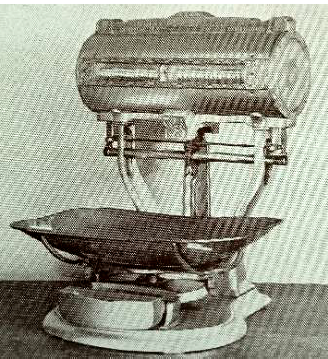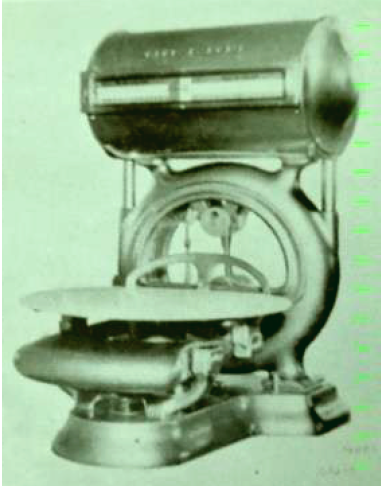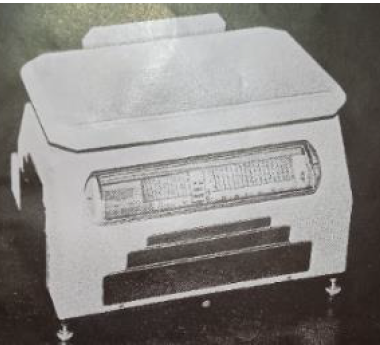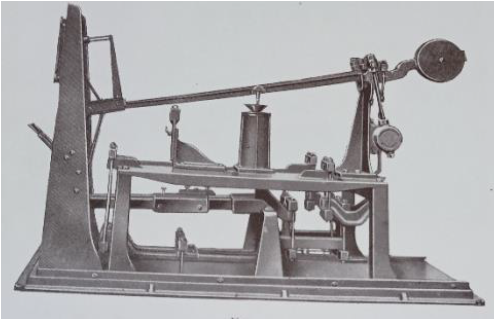In the previous weighing news, the necessity for the weighing and pricing scales and the
invention of steelyard type pricing scale were described. The steelyard type pricing scale was non automatic and was therefore slow in use.
Self– indicating Pricing Scales:
It was soon followed by the Dayton automatic computing Scale with suspended pan.

The swinging pan was replaced by a goods fitting on a Roberval
system. In 1907 Henry Pooley & Son Limited, by arrangement with
the Dayton Computing Scale Company,
successfully submitted to the British
Board of Trade, a scale of the
type illustrated in the figure.
One of the chief modifications to this type was the introduction
of a pendulum resistant unit in place of springs, by the Toledo
Scale Company of U.S.A. Figure shows the first scale of
pendulum type brought to England, sold through the agency of
W.& T. Avery Limited.


These cylinder type of Scales usually had a capacity of
twenty pounds, with a minor division on the chart of half –
an – ounce. Since the Board of Trade Regulation required,
on verification, an accuracy of a subdivision, the Scale
should be accurate to 1 in 1280. Great skill and extreme
accuracy in manufacturing made it possible for the
commercial production of reliable scales to this standard.
Industrial Self – indicating Scales
Many ideas for heavy capacity scales of the self-indicating type were tried and several of these
became obsolete.
In the beautifully illustrated book “A Short History of Weighing” written by L.Sanders and published in 1947 by history employers W. & T. Avery Ltd., there is a reproduced page from a weighing machine catalogue issued by Henry & Son Ltd., in 1859 showing a spring dial platform scale in use in railway parcels office. Mr. Sanders said – and no one could speak with greater authority – that this was probably the first self-indicating platform scale used for industrial purposes. Henry Pooley constructed Hydrostatic balances as early as 1874 and some remained in use for many years.
In the beautifully illustrated book “A Short History of Weighing” written by L.Sanders and published in 1947 by history employers W. & T. Avery Ltd., there is a reproduced page from a weighing machine catalogue issued by Henry & Son Ltd., in 1859 showing a spring dial platform scale in use in railway parcels office. Mr. Sanders said – and no one could speak with greater authority – that this was probably the first self-indicating platform scale used for industrial purposes. Henry Pooley constructed Hydrostatic balances as early as 1874 and some remained in use for many years.

In 1907 Henry Pooley& Son Limited, introduced
their “quadrant indicator” a massively constructed
pendulous lever, carrying at one end a quadrant
with a specially designed chart having an inclined
vernier scale enabling small subdivisions of weight
to be read. In the indicator shown in the figure, the
chart and window are hidden behind uprights.
An important invention, known as the Aerostat, was made by Mr. Stickig at the beginning of
the 20th century. This mechanism operated on a principle which formed the basis of many
dial weighing machines.
The Aerostat mechanism was applied to platform Scales and weighbridges by W. & T. Avery Limited, in 1906.
The Aerostat mechanism was applied to platform Scales and weighbridges by W. & T. Avery Limited, in 1906.
In 1924, Avery introduced a semi – self-indicating platform scale
which was marked with very small subdivisions of weight. Figure
shows one variation of this model, the invention of C.Mc.G.Sykes.
Essentially there was a steelyard with sliding poise for balancing
the major units of load and a subsidiary pendulous resistant unit
which gave automatic indication of the minor divisions.
